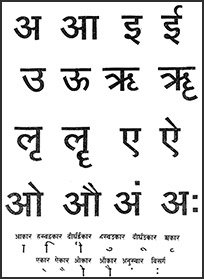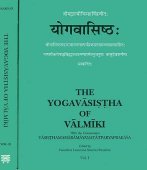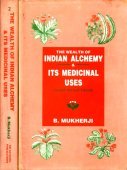Samuccaya: 25 definitions
Introduction:
Samuccaya means something in Buddhism, Pali, Hinduism, Sanskrit, Marathi, Jainism, Prakrit, Hindi. If you want to know the exact meaning, history, etymology or English translation of this term then check out the descriptions on this page. Add your comment or reference to a book if you want to contribute to this summary article.
Alternative spellings of this word include Samuchchaya.
In Hinduism
Arthashastra (politics and welfare)
Source: Wisdom Library: ArthaśāstraSamuccaya (समुच्चय) refers to “compounding together” and is the name of a yukti, or ‘technical division’, according to which the contents of the Arthaśāstra by Cāṇakya are grouped. Cāṇakya (4th-century BCE), aka Kauṭilya, was the chief minister of Chandragupta Maurya, the founder of the famous Maurya Empire.

Arthashastra (अर्थशास्त्र, arthaśāstra) literature concerns itself with the teachings (shastra) of economic prosperity (artha) statecraft, politics and military tactics. The term arthashastra refers to both the name of these scientific teachings, as well as the name of a Sanskrit work included in such literature. This book was written (3rd century BCE) by by Kautilya, who flourished in the 4th century BCE.
Vyakarana (Sanskrit grammar)
Source: Wikisource: A dictionary of Sanskrit grammarSamuccaya (समुच्चय).—Accumulation which is one of the four senses of the indeclinable च (ca) and which means the anticipation of an allied another by the express mention of one, in which sense the Dvandva compound prescribed by the rule चार्थे द्वन्द्वः (cārthe dvandvaḥ) does not take place; cf. समुच्चयः । प्लक्षश्च इत्युक्ते गम्यत एतन्न्यग्रोधश्चेति (samuccayaḥ | plakṣaśca ityukte gamyata etannyagrodhaśceti) M. Bh. on P. II. 2.29 Vart. 15.

Vyakarana (व्याकरण, vyākaraṇa) refers to Sanskrit grammar and represents one of the six additional sciences (vedanga) to be studied along with the Vedas. Vyakarana concerns itself with the rules of Sanskrit grammar and linguistic analysis in order to establish the correct context of words and sentences.
Shaktism (Shakta philosophy)
Source: Shodhganga: Iconographical representations of Śiva (shaktism)Samuccaya (समुच्चय) or Samuccayatantra refers to one of the thirty-three Dakṣiṇatantras, belonging to the Śāktāgama (or Śāktatantra) division of the Āgama tradition. The Śāktāgamas represent the wisdom imparted by Devī to Īśvara and convey the idea that the worship of Śakti is the means to attain liberation. According to the Pratiṣṭhālakṣaṇasamuccaya of Vairocana, the Śāktatantras are divided into to four parts, the Samuccaya-tantra belonging to the Dakṣiṇa class.

Shakta (शाक्त, śākta) or Shaktism (śāktism) represents a tradition of Hinduism where the Goddess (Devi) is revered and worshipped. Shakta literature includes a range of scriptures, including various Agamas and Tantras, although its roots may be traced back to the Vedas.
Kavyashastra (science of poetry)
Source: Shodhganga: The Kavyavilasa of Ciranjiva Bhattacarya (kavyashastra)Samuccaya (समुच्चय) refers to one of the 93 alaṃkāras (“figures of speech”) mentioned by Cirañjīva Bhaṭṭācārya (fl. 17th century) in his Kāvyavilāsa and is listed as one of the 89 arthālaṃkāras (figure of speech determined by the sense, as opposed to sound).—Among the ancient Ālaṃkārikas Rudraṭa is the first to admit samuccaya. Ruyyaka (A.S.P. 159) in his Ālaṃkārasarvasa has defined samuccaya. When attributes and actions are described as occurring at a time it is samuccaya.
Cirañjīva defines samuccaya as:—“bhūyasāmekasambandhabhājāṃ gumphaḥ samuccayaḥ”.—“When many objects are described to be related with one thing it is called samuccaya”. Cirañjīva perhaps follows Jayadeva in defining this samuccaya. Jayadeva has given the same definition in his Candrāloka (V/97). According to Jayadeva when many attributes and actions are related with one thing, it is sammuccaya.
Example of the samuccaya-alaṃkāra:—
nipīya madirāṃ durodaravaśo vasāpaṅkilaṃ sadā’ tti piśitaṃ hitaṃ na khalu veda naivā’hitam |
ayaṃ patati dhāvati bhramati mūrcchati dhyāyati pratāmyati palāyate pralapati sphuratyañcati ||“The person who is under the control of dice having drunk fully is eating meat mixed with marrow of the flesh and does know neither good nor bad. He falls, runs, wonders, faiths, meditates, becomes extremely fatigued, flees away, raves, shines and goes away or worships”.
Notes: Here so many actions like patati, dhāvati, bhramati etc. are connected with the nominative ayaṃ on account of the relation of so many actions with single nominative ayaṃ that is the dice player. It is an example of samuccaya.
Source: Shodhganga: Bhismacaritam a critical studySamuccaya (समुच्चय, “concatenation”) refers to one of the various Alaṅkāras (‘figures of speech’) classified as Artha (‘sense’), as employed in the Bhīṣmacarita (Bhishma Charitra) which is a mahākāvya (‘epic poem’) written by Hari Narayan Dikshit.—A beautiful application of ‘samuccaya’ is found in IV.41 of Bhīṣmacarita, where the poet has shown a world of his own poetic description. Devavrata, while going in search of a guru Paraśurāma, observes the beauty of nature in the form of a beautiful dance of a peacock, sweet cooing of cuckoos etc. which entertained him also. The other examples are IX.12, XV.16 and XVII.50.

Kavyashastra (काव्यशास्त्र, kāvyaśāstra) refers to the ancient Indian tradition of poetry (kavya). Canonical literature (shastra) of the includes encyclopedic manuals dealing with prosody, rhetoric and various other guidelines serving to teach the poet how to compose literature.
Ayurveda (science of life)
Source: gurumukhi.ru: Ayurveda glossary of termsSamuccaya (समुच्चय):—[samuccayaḥ] Words, sentence or paragraphs where in a multitude of things possessing some common property are grouped together and enumerated

Āyurveda (आयुर्वेद, ayurveda) is a branch of Indian science dealing with medicine, herbalism, taxology, anatomy, surgery, alchemy and related topics. Traditional practice of Āyurveda in ancient India dates back to at least the first millenium BC. Literature is commonly written in Sanskrit using various poetic metres.
Yoga (school of philosophy)
Source: ORA: Amanaska (king of all yogas): A Critical Edition and Annotated Translation by Jason BirchSamuccaya (समुच्चय) refers to a “multitude” (of scriptures), according to the Amanaska Yoga treatise dealing with meditation, absorption, yogic powers and liberation.—Accordingly, as Īśvara says to Vāmadeva: “[...] Some who are full of pride because they know a multitude of scriptures (śāstra-samuccaya), do not know the [true] teaching, not even by [studying] hundreds of texts. [Because their minds] are agitated by hundreds of conceptual processes consisting of meditation and so forth, [all of which are] grounded in desire [for some particular reward], they do not find the desired state that is to be obtained, however hard they torture [themselves]. [...]”.

Yoga is originally considered a branch of Hindu philosophy (astika), but both ancient and modern Yoga combine the physical, mental and spiritual. Yoga teaches various physical techniques also known as āsanas (postures), used for various purposes (eg., meditation, contemplation, relaxation).
In Buddhism
Tibetan Buddhism (Vajrayana or tantric Buddhism)
Source: Google Books: The Lamp for Integrating the Practices (Caryamelapakapradipa)Samuccaya (समुच्चय) refers to an “assembly” (e.g., ‘the assembly of all Siddhis’ or ‘the assembly of meditation’), according to the 9th-century Caryāmelāpakapradīpa (“The Lamp for Integrating the Practices”) by Āryadeva, which represents a comprehensive exposition of the Guhyasamāja-tantra.—Accordingly, as the Vajra Mentor said: “Excellent, excellent, Great One! I will explain the practice without elaboration according to the tradition of the Great Yoga Tantra, the Glorious Esoteric Community. Listen with one-pointed attention! In a region that is agreeable to the mind as described in the Tantras, [that is]: ‘In regions of great wilderness provided with fruits, flowers, and the like; on a lonely mountain should this assembly of meditation (dhyāna-samuccaya) be practiced’. Having consecrated either a single-story cottage or a raised platform according to the rite as it has been explained, and having imaginatively created there a celestial palace with a vajra and a jewel peak, with features such as having four corners, and so on, thereafter, [...]”.
Note: The standard version reads “the assembly of all Siddhis” (sarva-siddhi-samuccayaṃ) for “this assembly of meditation” (idaṃ dhyāna-samuccayaṃ).

Tibetan Buddhism includes schools such as Nyingma, Kadampa, Kagyu and Gelug. Their primary canon of literature is divided in two broad categories: The Kangyur, which consists of Buddha’s words, and the Tengyur, which includes commentaries from various sources. Esotericism and tantra techniques (vajrayāna) are collected indepently.
Languages of India and abroad
Pali-English dictionary
Source: BuddhaSasana: Concise Pali-English Dictionarysamuccaya : (m.) collection; accumulation.
Source: Sutta: The Pali Text Society's Pali-English DictionarySamuccaya, (saṃ+uccaya) collection, accumulation J. II, 235 (the signification of the particle vā); SnA 266 (id.).—samuccaya-kkhandhaka the third section of Cullavagga Vin. II, 38—72. (Page 687)

Pali is the language of the Tipiṭaka, which is the sacred canon of Theravāda Buddhism and contains much of the Buddha’s speech. Closeley related to Sanskrit, both languages are used interchangeably between religions.
Marathi-English dictionary
Source: DDSA: The Molesworth Marathi and English Dictionarysamuccaya (समुच्चय).—m (S) Assemblage, collection, accumulation, aggregate; a multitude or a mass. 2 By meton. A decision or settlement of a matter by an assembly. 3 In grammar. Conjunction of words, clauses, or sentences; the power of the particle and or also.
Source: DDSA: The Aryabhusan school dictionary, Marathi-Englishsamuccaya (समुच्चय).—m Assemblage. A decision of a matter by an assembly.
Marathi is an Indo-European language having over 70 million native speakers people in (predominantly) Maharashtra India. Marathi, like many other Indo-Aryan languages, evolved from early forms of Prakrit, which itself is a subset of Sanskrit, one of the most ancient languages of the world.
Sanskrit dictionary
Source: DDSA: The practical Sanskrit-English dictionarySamuccaya (समुच्चय).—
1) Collection, assemblage, aggregation, mass, multitude.
2) Conjunction of words or sentences; see च (ca).
3) A figure of speech; K. P.1 (Kārikās 115 and 116); (it consists in joining together two or more things, independent of each other, but connected in idea with reference to some common action).
Derivable forms: samuccayaḥ (समुच्चयः).
Source: Cologne Digital Sanskrit Dictionaries: Shabda-Sagara Sanskrit-English DictionarySamuccaya (समुच्चय).—m.
(-yaḥ) 1. Assemblage, collection, either in thought or fact. 2. Conjunction of words or sentences, the power of the particle and, or also; but it implies the conjunction of different objects of one act or different acts with the same object, as īśvaraṃ guruñca bhajasva worship God, and (or also) the Guru. E. sam and ud before ci to collect, aff. ac or ṇac .
Source: Cologne Digital Sanskrit Dictionaries: Benfey Sanskrit-English DictionarySamuccaya (समुच्चय).—i. e. sam-ud -ci + a, m. 1. Collection, [Cāṇakya] 2 in Berl. Monatsb. 1864, 407. 2. Coniunction of words or sentences.
Source: Cologne Digital Sanskrit Dictionaries: Cappeller Sanskrit-English DictionarySamuccaya (समुच्चय).—[masculine] heap, mass, multitude, a whole or aggregate; addition, copulative relation ([grammar]).
Source: Cologne Digital Sanskrit Dictionaries: Aufrecht Catalogus CatalogorumSamuccaya (समुच्चय) as mentioned in Aufrecht’s Catalogus Catalogorum:—in dharma. See Pratiṣṭhā, Prāyaścitta, Vyava-hāra, Śrāddha, Smṛti, Smṛtisāra.
Source: Cologne Digital Sanskrit Dictionaries: Monier-Williams Sanskrit-English Dictionary1) Samuccaya (समुच्चय):—[=sam-uccaya] [from samuc-ci] m. aggregation, accumulation, collection, assemblage, multitude, [Kāvya literature]
2) [v.s. ...] totality, aggregate, [Kāvya literature; Suśruta; Kathāsaritsāgara]
3) [v.s. ...] conjunction of words or sentences (as by the particle ca, ‘and’), conjunctive sense (opp. to the disjunctive vā, ‘or’), [Nirukta, by Yāska; Gṛhya-sūtra; Suśruta] etc.
4) [v.s. ...] (in [rhetoric]) a figure of speech (the joining together of two or more independent things associated in idea with some common action), [Sāhitya-darpaṇa; Kāvyaprakāśa]
Source: Cologne Digital Sanskrit Dictionaries: Yates Sanskrit-English DictionarySamuccaya (समुच्चय):—[samu-ccaya] (yaḥ) 1. m. Assemblage, collection, conjunction.
Source: DDSA: Paia-sadda-mahannavo; a comprehensive Prakrit Hindi dictionary (S)Samuccaya (समुच्चय) in the Sanskrit language is related to the Prakrit word: Samuccaya.
[Sanskrit to German]
Sanskrit, also spelled संस्कृतम् (saṃskṛtam), is an ancient language of India commonly seen as the grandmother of the Indo-European language family (even English!). Closely allied with Prakrit and Pali, Sanskrit is more exhaustive in both grammar and terms and has the most extensive collection of literature in the world, greatly surpassing its sister-languages Greek and Latin.
Hindi dictionary
Source: DDSA: A practical Hindi-English dictionarySamuccaya (समुच्चय) [Also spelled samuchchy]:—(nm) set; collection, aggregate/aggregation, totality, assemblage; conjunction of words or sentences; [bodhaka] conjunction.
...
Prakrit-English dictionary
Source: DDSA: Paia-sadda-mahannavo; a comprehensive Prakrit Hindi dictionarySamuccaya (समुच्चय) in the Prakrit language is related to the Sanskrit word: Samuccaya.
Prakrit is an ancient language closely associated with both Pali and Sanskrit. Jain literature is often composed in this language or sub-dialects, such as the Agamas and their commentaries which are written in Ardhamagadhi and Maharashtri Prakrit. The earliest extant texts can be dated to as early as the 4th century BCE although core portions might be older.
Kannada-English dictionary
Source: Alar: Kannada-English corpusSamuccaya (ಸಮುಚ್ಚಯ):—
1) [noun] a group of persons, animals or things; a crowd; a multitude.
2) [noun] a heap of things; a pile.
3) [noun] the state of being joined, united; union.
4) [noun] (rhet.) a figure of speech that expresses different kinds of feelings.
5) [noun] (gram.) any of several particles used as a conjuction (as ಅಂ, ಉಂ, ಅಥವಾ [am, um, athava] etc.).
Kannada is a Dravidian language (as opposed to the Indo-European language family) mainly spoken in the southwestern region of India.
See also (Relevant definitions)
Partial matches: Samu, Uccaya, Sam, Camu.
Starts with: Samuccaya Khandha, Samuccayabodhaka, Samuccayalamkara, Samuccayam, Samuccayana, Samuccayaprayashcitta, Samuccayarthaka, Samuccayatantra, Samuccayopama.
Ends with (+87): Abhidharmasamuccaya, Acaryakriyasamuccaya, Akulagame yogasarasamuccaya, Anekarthasamuccaya, Asurikalpasamuccaya, Bhagavatasarasamuccaya, Bharatasamuccaya, Bhavaratnasamuccaya, Bodhisattvasamuccaya, Caturvimshatismritidharmasarasamuccaya, Cikitsasarasamuccaya, Danadipavakyasamuccaya, Danavakyasamuccaya, Dharmasarasamuccaya, Dhavalapuranasamuccaya, Dhyanasamuccaya, Dravyasamuccaya, Itihasasamuccaya, Jinadattakathasamuccaya, Jnananandasamuccaya.
Full-text (+177): Samuccayam, Samuccayopama, Samuccayalamkara, Caya, Rasaratnasamuccaya, Samuccayana, Yogasara, Vakyapadiya, Tripurasara, Pratishthasamuccaya, Sarasamuccaya, Vishnusamuccaya, Shraddhasamuccaya, Prashnasamuccaya, Manasamuccayatika, Sheshasamuccayatika, Ratnasamuccaya, Vacanasamuccaya, Shikshasamuccaya, Vastusamuccaya.
Relevant text
Search found 58 books and stories containing Samuccaya, Sam-uccaya, Samu-ccaya; (plurals include: Samuccayas, uccayas, ccayas). You can also click to the full overview containing English textual excerpts. Below are direct links for the most relevant articles:
Sahitya-kaumudi by Baladeva Vidyabhushana (by Gaurapada Dāsa)
Text 10.161 [Samuccaya] < [Chapter 10 - Ornaments of Meaning]
Text 10.165 < [Chapter 10 - Ornaments of Meaning]
Text 10.251 < [Chapter 10 - Ornaments of Meaning]
Vakyapadiya of Bhartrihari (by K. A. Subramania Iyer)
Verse 2.195 < [Book 2 - Vākya-kāṇḍa]
Book 1 - Brahma-kāṇḍa (or Āgama-samuccaya)
Verse 3.14.470 < [Book 3 - Pada-kāṇḍa (14): Vṛtti-samuddeśa (On Ccomplex Formation)]
Hari-bhakti-kalpa-latikā (by Sarasvati Thkura)
Text 24-25 < [First Stabaka]
Vasudevavijaya of Vasudeva (Study) (by Sajitha. A)
Dvandva-samāsa (Compound) < [Chapter 3 - Vāsudevavijaya—A Grammatical Study]
Sanskrit sources of Kerala history (by Suma Parappattoli)
5.4. Syanandurapuravarnana-samuccaya < [Chapter 2 - Historical details from Mahatmyas and Prashastis]
Expiatory Rites in Keralite Tantra (by T. S. Syamkumar)
3. Dynamics of Expiatory Rites in Keralite Tantra < [Chapter 4 - Socio-Cultural aspects of Expiatory Rites]
3.1. Expiatory Rites in Śeṣasamuccaya < [Chapter 3 - Expiatory Rites in Kerala Tantric Ritual Manuals]
3.3. Expiatory Rites in Tantraprāyaścitta < [Chapter 3 - Expiatory Rites in Kerala Tantric Ritual Manuals]
Related products


